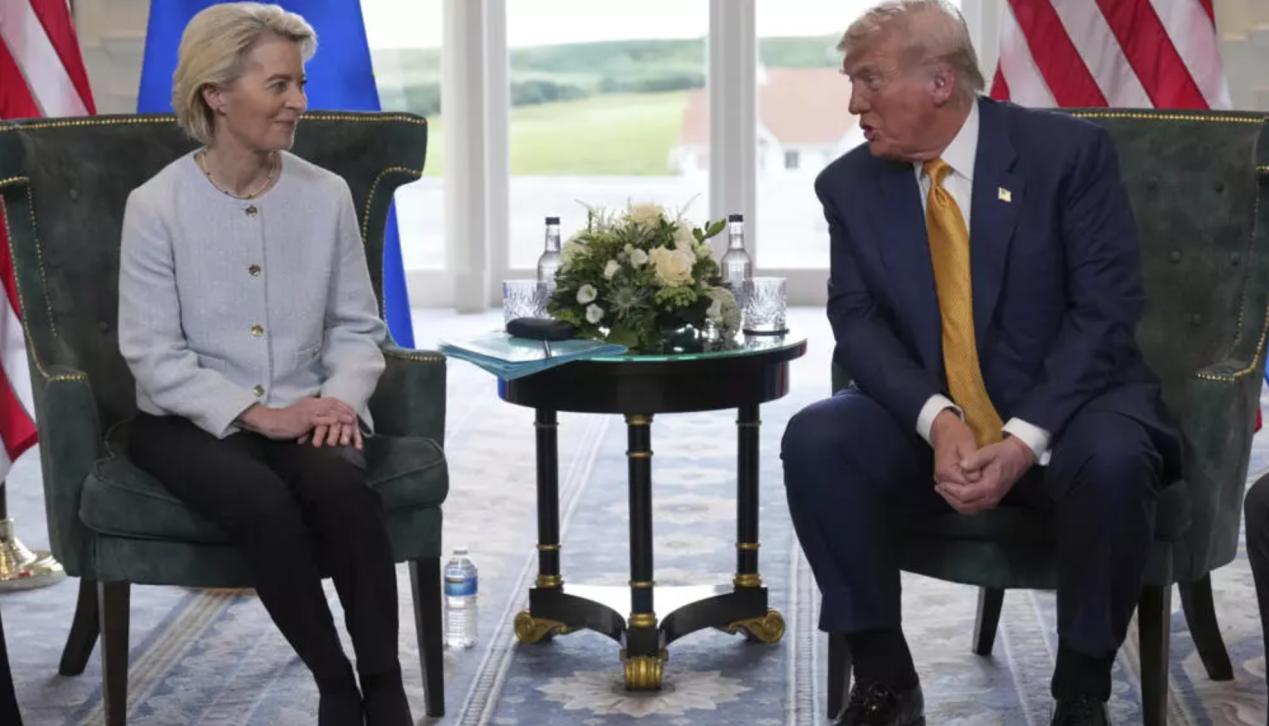
On July 27, 2025, US President Trump and European Commission President Ursula von der Leyen reached a highly anticipated trade agreement: The US will impose a uniform 15% tariff on EU goods exported to the US, while the EU has committed to increasing its investment in the US by 600 billion dollars and purchasing 750 billion dollars worth of US energy products and "hundreds of billions of dollars" worth of military equipment. The signing of this agreement marks a shift from "threat escalation" to "limited compromise" in the US-EU trade war, but the underlying game logic and global impact of this agreement deserve in-depth analysis.
I. Agreement Reached: A Dramatic Turn from Threat to Compromise
1. Negotiation Background: Trade Deficit and Tariff Threats
In 2024, the US trade deficit with the EU reached a staggering 235 billion dollars. The Trump administration long accused the EU of "crushing the US economy" and repeatedly threatened to impose a 30% tariff on EU goods. On July 12, 2025, Trump announced that the threat would be implemented starting August 1, causing global market panic. The EU countered with its "Anti-Coercion Instrument" (ACI) and a retaliatory tariff list worth 93 billion euros, leading to a tense standoff between the two sides.
2. Key Turning Point: Closed-Door Negotiations and Interest Exchange
One week before the deadline, von der Leyen and Trump held closed-door negotiations, ultimately reaching a compromise: the tariff rate was reduced from 30% to 15%, and the EU abandoned its retaliatory tariffs while committing to large-scale purchases of US energy and military equipment. This outcome not only averted a full-scale trade war but also provided a "political victory" for the US - Trump claimed it was "one of the biggest deals ever," while the EU stabilized market expectations of a trade war through the agreement.
II. Agreement Content: Redistributing Interests in Compromise
1. Tariff Structure: 15% "Benchmark Rate"
The agreement sets a uniform tariff of 15% for key industries such as automobiles, semiconductors, and pharmaceuticals, which is lower than the 30% initially threatened by Trump but higher than the EU's "zero-tariff" goal. Notably, the 50% high tariffs on steel and aluminum imposed by the US on the EU have not been lifted yet, with only a commitment to gradually reduce them through a quota system in the future. Moreover, the details of tariff exemptions in areas such as aircraft, spirits, and medical devices have not been finalized, posing potential risks in the implementation of the agreement.
2. EU Concessions: "Political Cost" of Investment and Procurement
The EU's commitment to invest 600 billion US dollars and purchase 750 billion US dollars worth of energy has been criticized by Bernd Lange, the chairperson of the European Parliament's trade committee, as "seriously imbalanced". For instance, the EU plans to significantly increase its imports of US liquefied natural gas to reduce its reliance on Russian energy, but this move may increase the EU's energy costs and undermine the development space of its domestic renewable energy industry. Military equipment procurement has been questioned as a "disguised protection of the interests of the US military-industrial complex".
3. US Benefits: Trade Deficit and Industrial Return
According to the agreement, US energy and military industries will directly benefit. In 2024, US energy exports to the EU were less than 50 billion US dollars, while the 750 billion US dollars in procurement promised by the agreement represents an average annual increase of 150 billion US dollars over the next five years. Additionally, US Commerce Secretary Lighthizer disclosed that the tariff policy on semiconductors will be determined within two weeks, further strengthening the US's control over high-end manufacturing.
III. Global Impact: Increased Certainty and Structural Contradictions
1. Short-Term Impact: Market Sentiment and Exchange Rate Fluctuations
After the announcement of the agreement, the euro rose by 0.2% against the US dollar, and the automotive sector of the European stock market led the gains, with the shares of Volkswagen and BMW climbing by up to 3% at one point. However, economists warn that the 15% tariff will still push up US inflation and weaken the competitiveness of EU exports. Capital Economics estimates that the agreement may reduce the EU's GDP growth rate by 0.3%, with Germany being the most affected.
2. Long-Term Game: Reconstruction of Global Trade Rules
The Trump administration has used the "tariff blackmail" strategy to reach similar agreements with Japan, the UK, Indonesia, and other countries, attempting to reshape a "America First" trade order. The EU's compromise has exposed its internal contradictions: export-oriented economies such as Germany support the agreement to avoid a trade war, while countries like France are concerned that their domestic industries will be controlled by US capital and technology.
The 15% tariff agreement between the US and the EU is a "limited victory": the US has narrowed its trade deficit through tariff blackmail, and the EU has exchanged investment for a pause in the trade war, but neither side has addressed the structural contradictions - the hollowing out of the US manufacturing industry and the decline in the competitiveness of the EU's industries. Against the backdrop of increasing economic fragmentation globally, this agreement may provide short-term certainty, but it cannot hide the deep crisis of the retreat of globalization. In the future, how to balance national interests and global cooperation will become a common challenge for all economies.

Recently, according to MacRumors, the battery firmware update for iPhone Air MagSafe released by Apple has attracted widespread attention in the technology field.
Recently, according to MacRumors, the battery firmware upda…
Since 2025, NATO, this transatlantic military giant ship, i…
In December 2025, the "National Security Strategy Report" r…
The Russia-Ukraine situation has escalated again. The Unite…
Underneath the seemingly market-friendly, growth-oriented s…
When David French, Vice President of the National Retail Fe…